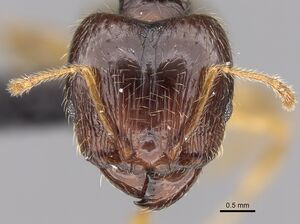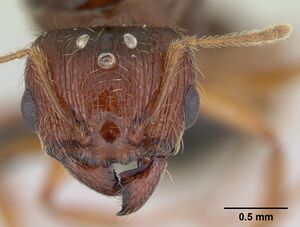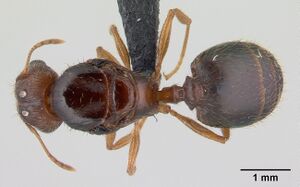Pheidole megatron
| Pheidole megatron | |
|---|---|

| |
| Scientific classification | |
| Kingdom: | Animalia |
| Phylum: | Arthropoda |
| Class: | Insecta |
| Order: | Hymenoptera |
| Family: | Formicidae |
| Subfamily: | Myrmicinae |
| Tribe: | Attini |
| Genus: | Pheidole |
| Species group: | megacephala |
| Species: | P. megatron |
| Binomial name | |
| Pheidole megatron Fischer & Fisher, 2013 | |
Pheidole megatron has been found under stones, in and under rotten logs, and nesting and foraging on the ground, occurring in coastal scrub, dry forest and in a coconut plantation, in elevations between 10 and 35 m.
Identification
Fischer and Fisher (2013) - Relatively small species (WL major 0.94–1.08, WL minor 0.63–0.72), minor and major workers with moderately short scapes and legs (SI major 52–55, SI minor 102–118, FI major 60–66, FI minor 117–131), propodeal spines short-triangular, promesonotal process absent or inconspicuous, standing hairs on mesosoma relatively coarse and rare, often blunt or apically bifurcate, with few shorter hairs in between. Major head not or very weakly heart-shaped, sometimes almost subrectangular, posterior emargination shallow, face longitudinally rugose anteriorly, sculpture on posterior 2/5 variable, from smooth and micropunctate to weakly and irregularly longitudinally rugulose, lateroventral corners of head in profile with relatively large weakly punctate area, hypostomal margin with submedian teeth very small to inconspicuous, median process absent, postpetiole on average about 1.9 times wider than petiole (PpWI 169–207). Minor head shape ovoid and distinctly longer than wide (CI 82–87), face and promesonotum completely smooth and shiny, postpetiole between 0.6 and 0.7 times as long as petiole (PpLI 63–71).
On Anjouan Island it occurs together with two likely relatives, Pheidole spinosa and Pheidole megacephala. From the former species, P. megatron can be distinguished by a slightly larger and more globular postpetiolar ventral process in the major workers and significantly less abundant standing hairs, which often end bluntly or apically split in both worker subcastes, compared to a slightly smaller, more angulate postpetiolar ventral process and relatively numerous, acute standing hairs in P. spinosa. The major workers of P. megatron tend to have a less heart- and more square-shaped head in full-face view than both P. spinosa and P. megacephala, with a shallower posterior emargination, and some to several longitudinal rugulae on the posterior 2/5 of the face, compared to an often heart-shaped head, with a deeper posterior emargination, and an almost completely smooth and shiny posterior head surface in P. spinosa and P. megacephala major workers. The minor workers of P. megatron have a slightly narrower head (CI 82–87 versus CI 87–94) and larger eyes (EI 23–26 versus EI 19–23) than those of P. spinosa and also a narrower head (CI 82-87 versus CI 86-92) and a slightly shorter postpetiole (PpLI 63-71 versus PpLI 70-91) than the minors of P. megacephala (see also under discussion of P. megacephala).
Keys including this Species
Distribution
P. megatron has been collected on the islands of Anjouan, Moheli, and Grand Comoro of the Comoros.
Latitudinal Distribution Pattern
Latitudinal Range: -11.3809° to -12.3805°.
| North Temperate |
North Subtropical |
Tropical | South Subtropical |
South Temperate |
- Source: AntMaps
Distribution based on Regional Taxon Lists
Afrotropical Region: Comoros (type locality).
Distribution based on AntMaps
Distribution based on AntWeb specimens
Check data from AntWeb
Countries Occupied
| Number of countries occupied by this species based on AntWiki Regional Taxon Lists. In general, fewer countries occupied indicates a narrower range, while more countries indicates a more widespread species. |

|
Estimated Abundance
| Relative abundance based on number of AntMaps records per species (this species within the purple bar). Fewer records (to the left) indicates a less abundant/encountered species while more records (to the right) indicates more abundant/encountered species. |

|
Biology
Castes
Worker
minor
Images from AntWeb
   
| |
| Paratype of Pheidole megatron. Worker. Specimen code casent0281179. Photographer Estella Ortega, uploaded by California Academy of Sciences. | Owned by CAS, San Francisco, CA, USA. |
major
Images from AntWeb
   
| |
| Holotype of Pheidole megatron. Worker (major/soldier). Specimen code casent0147194. Photographer Cerise Chen, uploaded by California Academy of Sciences. | Owned by CAS, San Francisco, CA, USA. |
Queen
Images from AntWeb
   
| |
| Paratype of Pheidole megatron. Queen (alate/dealate). Specimen code casent0147219. Photographer Erin Prado, uploaded by California Academy of Sciences. | Owned by CAS, San Francisco, CA, USA. |
Nomenclature
The following information is derived from Barry Bolton's Online Catalogue of the Ants of the World.
- megatron. Pheidole megatron Fischer & Fisher, 2013: 338, figs. 22A-F (s.w.) COMOROS.
Unless otherwise noted the text for the remainder of this section is reported from the publication that includes the original description.
Description
Worker
Fischer and Fisher (2013) - Major (holotype): HW 1.22, HL 1.16 SL 0.59, MDL 0.63, EL 0.16, WL 0.97, PNH 0.39, PNW 0.56, MNH 0.62, PDH 0.36, PTL 0.38, PPL 0.24, PTH 0.23, PPH 0.27, PTW 0.16, PPW 0.31, PSL 0.14, MFL 0.83, MTL 0.61, CI 105, SI 48, MDI 52, EI 13, FI 68, PSLI 11, LPpI 89, DPpI 129, PpWI 194, PpLI 63, PpHI 117.
(n=5): HW 1.10–1.32 (1.19), HL 1.04–1.33 (1.17), SL 0.61–0.68 (0.63), MDL 0.59–0.71 (0.65), EL 0.15–0.17 (0.16), WL 0.94–1.08 (0.99), PNH 0.36–0.43 (0.40), PNW 0.54–0.63 (0.58), MNH 0.61–0.70 (0.64), PDH 0.33–0.40 (0.36), PTL 0.31–0.44 (0.38), PPL 0.23–0.27 (0.25), PTH 0.20–0.28 (0.25), PPH 0.22–0.28 (0.23), PTW 0.14–0.19 (0.16), PPW 0.27–0.35 (0.30), PSL 0.13–0.15 (0.14), MFL 0.77–0.93 (0.84), MTL 0.59– 0.69 (0.62), CI 99–106 (103), SI 52–55 (53), MDI 54–57 (55), EI 13–15 (14), FI 69–72 (71), PSLI 11–13 (12), LPpI 96–108 (101), DPpI 112–132 (122), PpWI 169–207 (185), PpLI 61–76 (70), PpHI 109–113 (110).
Head on average slightly longer than wide (CI 99–106), subquadrate, with weakly convex sides and posterior emargination usually shallow. Mandibles moderately long (MDI 52–57), smooth and shiny. Clypeus smooth with very short median carina and one pair of lateral carinae present. Face sculpture anteriorly longitudinally rugose (as in P. megacephala), sculpture on posterior 2/5 of head variable, from mostly smooth with micropunctures and faint short rugulae posteromedially to micropunctate without rugulation to weakly and irregularly longitudinally rugulose with smooth to superficially punctate interspaces. Frontal carinae very short, antennal scrobe absent. Scapes of medium length (SI 48–55) with decumbent to subdecumbent pilosity and few longer suberect to erect hairs along outer edge. Submedian hypostomal teeth very small to inconspicuous, median process absent. Promesonotum in profile convex and without prominent promesonotal process, posterior declivity often weakly marginate anteriorly (at posterior end of pronotum), oblique and angulate at its lower portion. Dorsum of promesonotum smooth or superficially punctate, anterior lateropronotum smooth, and remainder of mesosoma densely and finely punctate. Metanotal groove barely or not impressed, cross-ribs inconspicuous to superficially developed. Spines short, acute, subtriangular, much shorter than distance between their bases (PSLI 11–13). Metafemur relatively short (FI 68–72), metatibia pilosity on inner edge decumbent, on outer edge decumbent to suberect. Postpetiole about as long as high (LPpI 89–108), in profile with rounded to bluntly acute, anteriorly directed ventral process, in dorsal view trapezoidal with rounded lateral corners, on average 1.9 times wider than petiole (PpWI 169–207). Dorsum of petiole and postpetiole smooth to superficially punctate, remainder punctate. Gaster smooth, anteriorly micropunctate. Dorsal body surfaces with relatively stiff standing hairs of variable lengths, with some long, thin, acute hairs and shorter, moderately abundant, decumbent to suberect pilosity between. Color brown, with lighter appendages and darker gaster.
Minor (n=6): HW 0.47–0.52 (0.50), HL 0.55–0.61 (0.58), SL 0.52– 0.61 (0.56), MDL 0.32–0.35 (0.34), EL 0.12–0.13 (0.12), WL 0.63–0.72 (0.68), PNH 0.22–0.25 (0.23), PNW 0.25–0.33 (0.31), MNH 0.40–0.45 (0.43), PDH 0.22–0.40 (0.26), PTL 0.22–0.24 (0.23), PPL 0.14–0.17 (0.16), PTH 0.13–0.14 (0.13), PPH 0.15–0.17 (0.16), PTW 0.09–0.10 (0.09), PPW 0.16–0.18 (0.17), PSL 0.06–0.08 (0.07), MFL 0.57–0.65 (0.62), MTL 0.43–0.49 (0.46), CI 82–87 (85), SI 102–118 (113), MDI 67–72 (69), EI 23– 26 (24), FI 117–131 (125), PSLI 11–17 (14), LPpI 97–106 (100), DPpI 100–120 (109), PpWI 168–200 (181), PpLI 63–71 (67), PpHI 114–119 (116).
Head ovoid, relatively narrow, longer than wide (CI 82–87), sides convex, posterior head margin rounded, occipital carina narrow in full-face view, medially impressed. Mandibles relatively short (MDI 67–72), smooth. Clypeus and remainder of face smooth, clypeal carinae absent or very faint, few concentric rugulae present around antennal insertion and in some specimens few weak malar carinae reaching to median eye level. Scapes relatively short (SI 102–118), when laid back surpassing posterior head margin by little more than length of tenth funicular segment, with subdecumbent pilosity and few suberect longer hairs along outer edge. Promesonotal outline in lateral view roundly convex, declining evenly from highest point toward metanotal groove, posterior process absent. Metanotal groove in profile narrow and weakly impressed, with two weak to superficial cross-ribs dorsally. Propodeum about as long as high, in profile declining toward spines. Propodeal spines short-triangular, acute and much shorter than distance between their bases (PSLI 11–17, mean 14). Promesonotum smooth, except punctures anteriorly near the neck and laterally at mesonotum, mesopleuron and propodeum punctate, with smooth spot near propodeal spiracle. Metafemur short (FI 117–131), metatibia with subdecumbent pilosity. Postpetiole about as high as long (LPpI 97–106) and on average 0.7 times as long as petiole (PpLI 63–71), in profile with large convex ventral process. Petiole and postpetiole dorsally smooth, remainder weakly to superficially punctate. Gaster smooth and shiny. Standing hairs moderately rare, relatively short and stiff to moderately long, suberect, usually several to many hairs apically split or bifurcate, especially on mesosoma, waist segments, and gaster. Color light brown to brown, appendages lighter colored, gaster slightly darker.
Type Material
Holotype: (major worker), COMOROS, Mohéli, Lac Boundouni, 12.3792 S, 43.8517 E, 25 m, dry forest, under stone, collection code BLF20771, 20.i.2009 (B.L. Fisher et al.) (California Academy of Sciences: CASENT0147194).
Paratypes: (2 minor workers) same data as holotype (CASC: CASENT0147193, CASENT0059654); (1 major & 2 minor workers), COMOROS, Mohéli, Lac Boundouni, 12.3792 S, 43.8517 E, 25 m, dry forest, ex rotten log, collection code BLF20797, 20.i.2009 (B.L. Fisher et al.) (CASC: CASENT0147140, CASENT0147141); (1 major & 3 minor workers), Mohéli, Lac Boundouni, 12.3792 S, 43.8517 E, 25 m, dry forest, under stone, collection codes BLF20776 & BLF20770, 20.i.2009 (B.L. Fisher et al.) (The Natural History Museum: CASENT0147160, CASENT0147220; CASC: CASENT0147161, CASENT0147219); (1 major & 3 minor workers), Mohéli, Lac Boundouni, 12.3792 S, 43.8517 E, 25 m, dry forest, ex rotten log, collection code BLF20762 & BLF20758, 20.i.2009 (B.L. Fisher et al.) (CASC: CASENT01281179, CASENT0147183, CASENT0147241).
Etymology
This species is named after the Transformers character Megatron, merciless leader of the malevolent Decepticons. The name is a noun in apposition and thus invariable.
References
- Fischer, G. & Fisher, B.L. 2013. A revision of Pheidole Westwood (Hymenoptera: Formicidae) in the islands of the Southwest Indian Ocean and designation of a neotype for the invasive Pheidole megacephala. Zootaxa 3683, 301–356.
- Salata, S., Fisher, B.L. 2022. Taxonomic revision of the Pheidole megacephala species-group (Hymenoptera, Formicidae) from the Malagasy Region. PeerJ 10: e13263 (doi:10.7717/peerj.13263).
References based on Global Ant Biodiversity Informatics
- Fischer G. & Fisher B. L. 2013. A revision of Pheidole Westwood (Hymenoptera: Formicidae) in the islands of the Southwest Indian Ocean and designation of a neotype for the invasive Pheidole megacephala. Zootaxa 3683: 301-356

